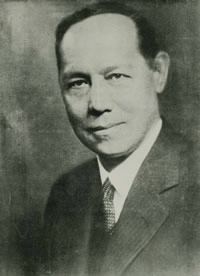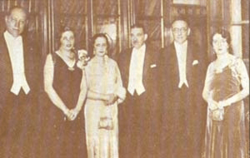Enrique Olaya Herrera facts for kids
Enrique Alfredo Olaya Herrera (born November 12, 1880 – died February 18, 1937) was a Colombian journalist and politician. He served as the 13th President of Colombia from August 7, 1930, to August 7, 1934. He belonged to the Colombian Liberal Party.
Quick facts for kids
Enrique Olaya Herrera
|
|
|---|---|
 |
|
| 13th President of Colombia | |
| In office 7 August 1930 – 7 August 1934 |
|
| Preceded by | Miguel Abadia Mendez |
| Succeeded by | Alfonso López Pumarejo |
| Colombian Ambassador to the Holy See | |
| In office 24 November 1935 – 18 February 1937 |
|
| President | Alfonso López Pumarejo |
| Preceded by | Carlos Emilio Restrepo |
| Succeeded by | Darío Echandía Olaya |
| Minister of Foreign Affairs | |
| In office 30 January 1935 – 18 May 1935 |
|
| President | Alfonso López Pumarejo |
| Preceded by | Darío Echandia |
| Succeeded by | Jorge Soto del Corral |
| In office 18 June 1935 – 9 October 1935 |
|
| President | Alfonso López Pumarejo |
| Preceded by | Jorge Soto del Corral |
| Succeeded by | Ernesto González Piedrahita |
| In office 21 November 1921 – 4 January 1922 |
|
| President | Jorge Holguín |
| Preceded by | Miguel Arroyo Diez |
| Succeeded by | Antonio Gómez Restrepo |
| In office 7 August 1910 – 23 November 1911 |
|
| President | Carlos Eugenio Restrepo |
| Preceded by | Carlos Caldero |
| Succeeded by | José Maria González Valencia |
| Minister of Agriculture and Commerce | |
| In office 11 November 1921 – 28 November 1921 |
|
| President | Jorge Holguín |
| Preceded by | Jesús del Corral |
| Succeeded by | Lucas Caballero |
| Personal details | |
| Born |
Enrique Alfredo Olaya Herrera
12 November 1880 Guateque Boyacá, United States of Colombia |
| Died | 18 February 1937 (aged 56) Rome, Lazio, Kingdom of Italy |
| Cause of death | Stroke |
| Political party | Liberal |
| Spouse | María Teresa Londoño Sáenz (1911-1937) |
| Children | María Olaya Londoño Lucía Olaya Londoño |
| Alma mater | Republican University of Colombia Université Libre de Bruxelles |
| Profession | Lawyer, Diplomat |
Contents
Early Life and Education
Enrique Olaya Herrera grew up in a time of big changes in Colombia. He was born in Guateque, Boyacá. His parents were Justiniano Olaya and Emperatriz Herrera.
When he was just 12 years old, Enrique started his own newspaper called El Patriota (The Patriot). This made him known as the "child journalist of Guateque." He even exchanged articles with major newspapers like El Espectador.
Olaya Herrera later studied law at the Universidad Republicana in Colombia. He also started another weekly magazine called El Estudiante (The Student). After finishing his law degree, he traveled to Belgium. There, he studied diplomacy and sociology at the Université Libre de Bruxelles.
Political Beginnings
Olaya Herrera was part of a group of important political and intellectual leaders. They were active around 1925 to 1940. This group is sometimes called the "Centennial Generation." Other famous members included Alfonso López Pumarejo and Eduardo Santos.
As a journalist, Olaya Herrera wrote for El Autonomista newspaper. He often criticized the government's policies. These policies were known as the "Regeneration." They aimed to bring the country back to a strong central government.
He also ran a newspaper called El Soldado Cubano (The Cuban Soldier) in his hometown. In this paper, he showed his admiration for the Cuban hero José Martí.
Joining the Liberal Party
The political tension between the Liberal Party and the Conservative Party grew very strong. This led to the Thousand Days War, a civil war. Olaya Herrera joined the Liberal Party and took part in the war. He fought with the liberal militias in a battle near Nocaima.
After the war, he continued his law studies. He earned his doctorate in 1904. In 1909, he spoke out against the government of General Rafael Reyes. This speech made him a key part of a movement against the dictatorship. This movement was called "Trecemarcismo" (March 13th Movement).
Constitutional Reforms
When President Reyes resigned, Olaya Herrera was elected to the Constituent Assembly. This group helped to change the Colombian Constitution of 1886. He worked with both Liberal and Conservative leaders. Together, they helped bring about a time of peace and national unity.
Carlos Eugenio Restrepo became president in 1910. He appointed Olaya Herrera as the first Minister of Foreign Relations. Olaya Herrera held this role again later, from 1921 to 1922. He also served as Minister of Agriculture. During the 1920s, he worked as a diplomat, improving Colombia's relationships with other countries, especially the United States.
Road to the Presidency
In the 1930s, the Liberal Party saw Olaya Herrera as the best person to win back the presidency. He was chosen as their presidential candidate in 1930. His political campaign was called "National Concentration."
Olaya Herrera won the election on February 9, 1930. He received many votes, defeating his opponents. Even some moderate Conservatives supported him.
Presidency of Colombia
As president, Olaya Herrera first tried to work with the opposition party. He gave them many government positions. However, these members were slowly removed from office.
His government focused on social issues and reforms. These included laws to protect workers and farmers. He also worked on public assistance programs.
Economic Challenges and War
The Wall Street Crash of 1929 caused economic problems worldwide. This affected Colombia too. President Olaya Herrera had to focus on these economic challenges. He started policies to protect national industries. This helped local businesses grow and reduced imports.
His term also faced the Colombia-Peru War. This war began in 1932 when Peruvian soldiers took over Leticia. Leticia was a port city in the Amazonas. A previous treaty, the Salomón–Lozano Treaty, had given Leticia to Colombia. But many Peruvians did not like this treaty.
General Alfredo Vázquez Cobo led Colombia's military operations in the south. The war was paid for by the government and by citizens who donated money and jewelry. The war ended in 1934 with the Rio Protocol. This agreement confirmed the earlier treaty and ended the border conflicts.
Public Works and Development
During his presidency, Olaya Herrera worked to develop Colombia's industries. He supported many infrastructure projects. These included new highways, seaports like Barranquilla and Buenaventura, and railroads. He also supported public education. He encouraged the exploration of natural resources like oil.
He also helped create new financial institutions. These included the Bank of Agrarian Credit (Caja de Crédito Agrario). This bank helped farmers. He also created the Mortgage Central Bank (Banco Central Hipotecario) to help people buy homes. His government also helped create the National Federation of Coffee Growers of Colombia. This organization helped improve coffee production and export. He also introduced important labor law reforms.
Public Order
During his first two years, there were some issues with public order. These problems were mainly in the Boyacá and Santander regions. They were often due to political disagreements.
After the Presidency
After his term as president ended in 1934, Olaya Herrera continued to serve Colombia. In 1935, he became Minister of Foreign Relations again. This was during the government of Alfonso López Pumarejo.
Later, he was appointed as Colombia's ambassador to the State of the Vatican City in Rome, Italy. He died there on February 18, 1937. He had been planning to run for president again when he returned to Colombia.
Personal Life

Enrique Olaya Herrera married María Teresa Londoño Sáenz in 1911. They had two daughters named Maria and Lucia.
See also
 In Spanish: Enrique Olaya Herrera para niños
In Spanish: Enrique Olaya Herrera para niños

